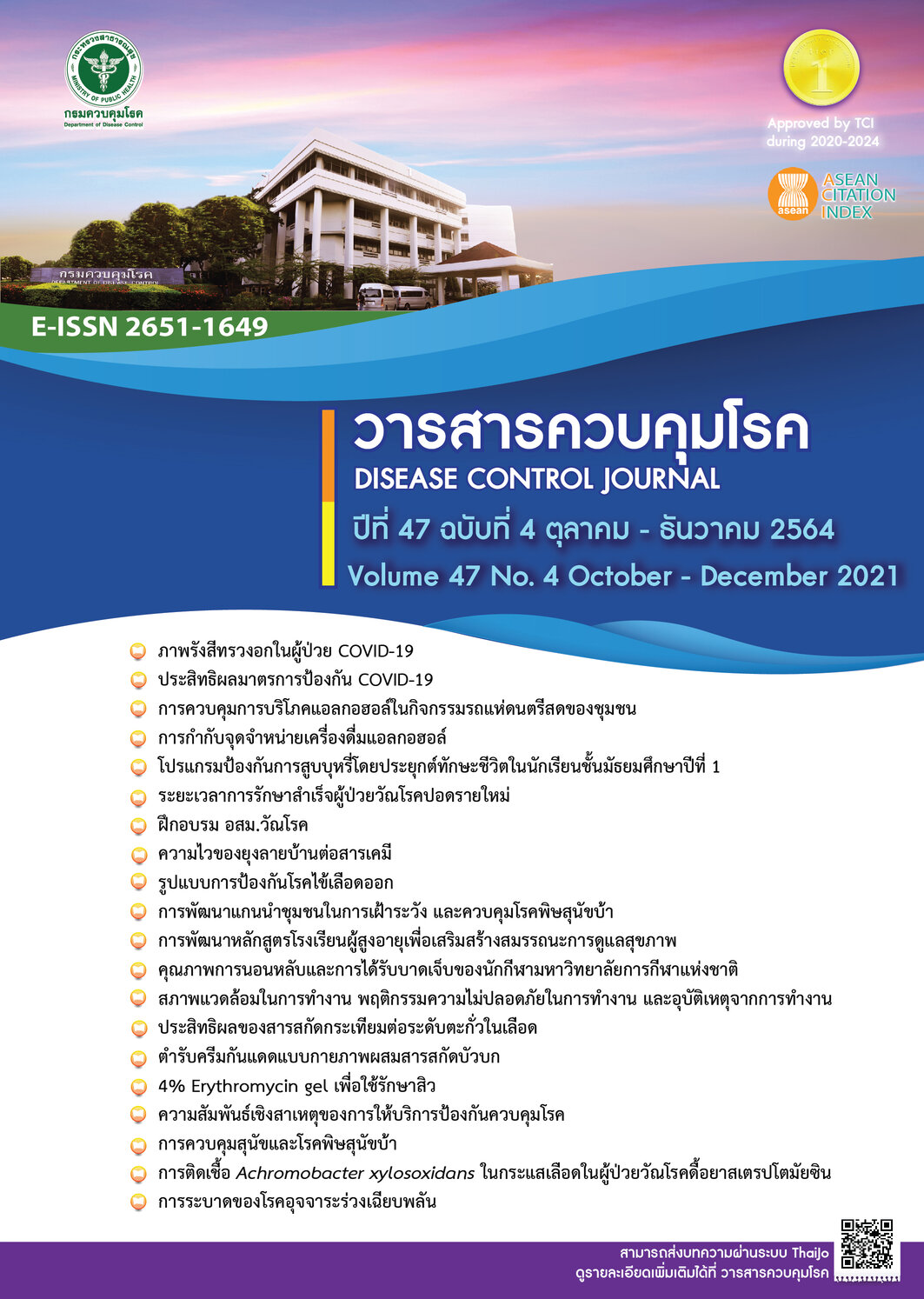Causal Relationship Model of Prevention and Control Service: Primary Care Unit in Public Health Region 3rd
DOI:
https://doi.org/10.14456/dcj.2021.93Keywords:
Prevention and Control Service, Primary Care Unit, Causal Relationship ModelAbstract
The purpose of this research was to analyze a Causal Relationship model of prevention and control service that influenced on prevention and control service of primary care unit in Public Health Region 3rd. The cross-sectional analytic study selected 267 public health officers who worked as a prevention and control service by simple random sampling. The data were collected by questionnaires. The latent variables consisted of the collaboration network, integration, and information technology, and the dependent variable was the service of prevention and control. The confirmatory factors were analyzed with AMOS. The research findings can be summarized as follows: The model is congruent with the evidence-based practice. The consideration was based on chi-square = 21.56, ϰ2/df = 0.86 and a probability value of 0..66 .Thus, it is evident that the chi-square value varied from zero with no statistical significance (GFI=0.98, AGFI= 0.96, SRMR = 0.04, RMSEA= 0.00). The weighted values of the factors were in the form of standard scores for the observed variables in the model for evaluating the service of prevention and control. In total, the positive values ranged from 0.76 to 0.96 with a statistical significance of 0.01. The latent variables had direct and indirectly influenced the service of prevention and control influence, information technology (0.39) integration (0.30) Collaboration Network (0.24), and the collaboration network (0.17). integration (0.15), respectively. All variables of the model could be used to explain the prevention and control service 72 percent. HCWs should focus on integrating and working with network partners in the local that had problems in concrete areas such as a guide, guideline, channels for coordination, adaptation of technology, had a central data center, connection and transfer data for improving the quality of life of the people.
Downloads
References
Mekthon S, Primary Care Cluster Operation Guideline For service units [Internet]. [cited 2019 Mar 20]. Available from: http://www. ylo.moph.go.th/webssjold/file2019/star/pro¬cess_PCC.pdf. (in Thai)
Ministry of Public Health. Primary Health Sys¬tems Act 2019 [Internet]. Nonthaburi. 2019 [cited 2019 Mar 20]. Available from: http: // www.ratchakitcha. Soc.go.th/DATA/PDF/ 2562 /A/056/T_0165.PDF. (in Thai)
Strategy and Planning Division Department of Disease Control. Demographic data midyear 2019 [Internet]. [cited 2019 Mar 20]. Available from: http://bps.moph.go.th/new_bps/. (in Thai)
Division of Communicable Diseases. Department of Disease Control. Non-communicable disease the number and rate of morbidity in the years 2016-2018 (hypertension, diabetes, coronary heart disease, COPD) [Internet]. [cited 2019 Mar 20]. Available from: http://www.thaincd. com /2016/mission3. (in Thai)
Bunjian P. Development of primary care network service system, Muang District, Loei Province. Journal of the Preventive Medicine Society of Thailand. 2016;6(1):38-8. (in Thai)
Sri Daorueng C, Prom P, Na Sakon Nakhon B. A valuable primary care unit management model for the National Health Security System, Region 8, Udon Thani Province. Journal of Health and Education Nursing. 2018;1(2):18-25. (in Thai)
Dejchareonchai S, Ruachai S, Chanphet J, Thewthong K. Public perception study on the importance of family doctor clinic services. Health System Research Institute [Internet]. [cited 2019 Mar 20]. Available from: http:// kb.hsri.or.th/dspace/handle/11228/4909?lo¬cale-attribute=th (in Thai)
Hair JF, Black WC, Babin BJ, Anderson RE. Multivariate data analysis. 7th ed. New Jersey:1082
Prentice Hall, Pearson Higher Education; 2010.
Kanjanawat S. Traditional test theory (CLASSI¬CAL TEST THEO RY) (Revised version). Print No. 7. Bangkok: Chulalongkorn University; 2013. (in Thai)
Kucharoenprasit R, Siriwanaarangsan P. Organi¬zation of primary health service in urban areas, a case study of Bangkok area 2017. Journal of the Preventive Medicine Society of Thailand. 2018;8(2):182-90. (in Thai)
Siriwanarangsan P, Chokkranitchai S. The orga¬nization of public health services at the district level: Bangkok area case study. Journal of the Preventive Medicine Society of Thailand 2018;8(1):152-61. (in Thai)
Chachiyom M, Thepsamritthiphon W. Strategic Development in Information Technology Com¬petency Of the administrators of the local gov¬ernment organization Phuket Province In gradu¬ate school Rajabhat Maha Sarakham University, RMU GRC 2017. 2nd Academic Conference of Graduate Studies, Rajabhat Maha Sarakham University 2017. (Pages 494-501). Ma¬hasarakham: Rajabhat Maha Sarakham Universi¬ty; 2017. (in Thai)
Downloads
Published
How to Cite
Issue
Section
License
Articles published in the Disease Control Journal are considered as academic work, research or analysis of the personal opinion of the authors, not the opinion of the Thailand Department of Disease Control or editorial team. The authors must be responsible for their articles.






